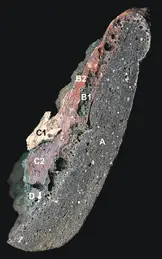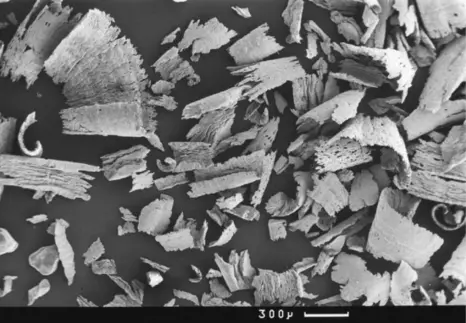Bronzemetallurgie in der Eisenzeit. Die späteisenzeitliche Bronzegießerwerkstatt im Oppidum von Kelheim (Niederbayern).
Im Zentrum des Projekts steht einer der umfangreichsten Fundkomplexe zur Bronzeverarbeitung der jüngeren Eisenzeit in Mitteleuropa. Das Fundmaterial, das bei Rettungsgrabungen innerhalb der riesigen Befestigungsanlage bei Kelheim (Niederbayern) geborgen wurde, umfasst neben ca. 800 Tiegelbruchstücken und zahllosen bronzenen Gussabfällen fast 2.000 Fragmente tönerner Gussformen des Wachsausschmelzverfahrens ("Guss in verlorener Form"). Materialanalysen an den verwendeten Metallen, Tiegeln und Gussformen geben detaillierte Einblicke in die Bronzetechnologie im ersten Jahrhundert v. Chr. Die Gussformfragmente sowie Fehlgüsse und Halbfabrikate ermöglichen Rückschlüsse auf Art und Menge der vor Ort produzierten Gegenstände. Demnach wurden in der Hauptsache Wagenbestandteile (Nabenringe, Deichsel- und Jochbeschläge) hergestellt. Im Verbund mit weiteren Fundmaterialien des Komplexes (Eisenabfälle, Schlacken) deutet sich an, dass nicht nur bronzene Wagenteile produziert wurden, sondern vollständige Wagen in Kelheim gefertigt worden sein könnten.
Die Durchführung des Projektes erfolgte mit Unterstützung des Städtischen Museums Kelheim (P. Neumann-Eisele M.A.). in Zusammenarbeit mit Dr. Werner Scharff (Gaildorf-Münster), der leider vor Abschluss der Untersuchungen im Oktober 2014 überraschend verstarb.
Zu den Gussform- und Tiegelfragmenten des Komplexes entstand an der Professur 2014 eine Magisterarbeit von Frau Anne-Elisabeth Harrer M.A.
Förderung: Sparkasse Kelheim, Stadt Kelheim, Ges. für Archäologie in Bayern.
Lit.:
Anne-Elisabeth Harrer, Die technische Keramik einer spätlatènezeitlichen Werkstatt aus dem Oppidum von Kelheim (Niederbayern). Unpubl. Magisterarbeit Univ. Bamberg 2014.
A. Schäfer, Zur Eisenverarbeitung im Oppidum von Manching. Schlacken und Herdfragmente der Ausgrabung Altenfeld 1996–1999. In: S. Sievers /M. Leicht/ B. Ziegaus, Ergebnisse der Ausgrabungen in Manching-Altenfeld 1996–1999. Ausgr. Manching 18/2 (Wiesbaden 2013) 295-335 (bes. 324-327).
A. Schäfer/ W. Scharff, The Ceramics of a Celtic Bronze Foundry from the Oppidum of Kelheim, Germany. In: S. Di Pierro/ V. Serneels/ M. Maggetti (Hrsg.), Ceramic in the Society. Proceedings of the 6th European Meeting on Ancient Ceramics Fribourg, Switzerland 3-6 October 2001 (Fribourg 2003) 261-266.
A. Schäfer, A Late Celtic Bronze Foundry from the Oppidum of Kelheim, Lower Bavaria, Germany. In: Proc. Internat. Conference "Archaeometallurgy in Central Europe III" at Her'lany, Slovakia 11.-13. Sept. 2000. Acta Metallurgica Slovaca (special issue) 7/2, 2001, 190-203.
A. Schäfer, Eine keltische Bronzegießerwerkstatt auf dem Mitterfeld im Oppidum von Kelheim. In: M. Rind (Hrsg.), Geschichte ans Licht gebracht. Archäologie im Landkreis Kelheim Bd. 3 (1997-1999) (Büchenbach 2000) 106-111.
The Ceramics of a Celtic Bronze Foundry from the Oppidum of Kelheim, Germany.
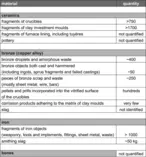
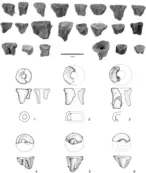

The oppidum of Kelheim on the confluence of the Altmühl and Danube Rivers in Lower Bavaria is one of the largest fortifications of the Celtic world. The walls of the latest phase, towards the mid first century B.C., enclose an area of almost 600 hectares. However, traces of dense Celtic occupation so far seem to be confined to the settlement terrace of the "Mitterfeld" along the Altmühl river at the foot of the Michelsberg acropolis (Leicht 2000). Here, in 1985 a large deposit of debris related to casting bronzes was discovered during rescue work prior to building activities (Röhrig 1985). The material derives from the infill of a well and two pits nearby and consists of hundreds of crucible fragments, almost 2000 pieces of clay investment moulds, some failed castings and plenty of other metal casting waste (Schäfer 2000, idem 2001). It may be appreciated as one of the largest deposits of foundry material known from the late Celtic Period (fig. 1 and fig. 8). Pottery and small finds provide a date around the mid 1st cent. BC, at the very end of Celtic occupation at Kelheim (Schäfer 2000, 110).
In the following we focus on the ceramic materials used in the pyrometallurgical processes involved, especially on the crucibles and mould fragments. The analytical research presented here was carried out as a pilot study for a more extensive research programme that is currently in planning.
The fragments of clay investment moulds show joins throughout the filling of the well. This is a clear indication of the whole assemblage representing the remains of a very short-lived activity.
The mould fragments exclusively derive from the lost-wax process. They seem to consist of at least two layers. Whether these vary in composition and may feature a particular lining on the matrix at the inner side is yet to be investigated. Of special significance are the sprue cups, i.e. the entrances to the moulds (fig. 2). About 200 fragments were recovered that may give some idea of the overall number of objects cast from these moulds. The majority of the fragments derive from moulds for the production of profiled nave rings for vehicles, others would have been used for casting smaller rings and further fittings clearly being part of a specific set (fig. 3). Along with tools and debris from an iron smithy as well as plenty of other iron artefacts and fittings, it is tempting to claim that (a) complete vehicle(s) would have been produced at the Kelheim workshop. Yet a detailed archaeological study of these materials will have to await the completion of conservation and metallurgical research.
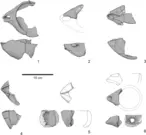
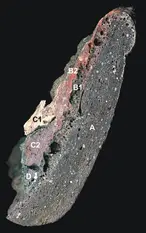
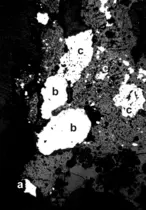
The crucible fragments also show joins throughout the layers of the well and at least to one of the nearby pits. They represent a rare type for the period, featuring a particular pouring lip or even a tubular spout, holding back floating charcoal and other residues when pouring the metal into the mould (fig. 4). The crucibles were heated from the top only (internal firing), not showing any signs of superheating on their exterior. This method is common for the late Iron Age, while earlier on during the Hallstatt and early La Tène Periods external firing predominated. Mineralogical research reveals that the crucibles were made from local colluvial clays tempered with organic materials, sometimes also containing considerable amounts of sand. The residues stuck to the inside and the rim of the crucibles consist of different types of slags, charcoal and metal prills and splashes, often incorporated into the vitrified surface of the vessels. First analyses (X-ray fluorescence analysis, scanning electronic microscope - EDX) confirm the melting of copper-based alloys. A cross section through a crucible wall shows different areas of interaction between container, charge and fuel (fig. 5). The metal residues adhering to the inner side of any one crucible may vary markedly in tin content. Larger metal residues contain about 5-10% of tin, while minor prills ( 0.5 mm) may feature Sn-contents of up to 40% or even 60%. The varying hues of the metal inclusions (red, yellow, silvery) provide an easy way of differentiation. Fig. 6 shows a metallographic section from an area corresponding to zones fig. 5, C-D, with metal inclusions in a matrix of metal oxides. This is a clear indication that reducing conditions were not upheld continually throughout the melting process. At the bottom of a crucible that had been used before, tiny metal particles could be detected sticking to the vitrified surface. The scanning electron microscope allows an identification as debris from bronze turning (fig. 7), attesting to the collecting and melting down of bronze scrap (cf. Northover 1991, 412-413 fig. 7.70). A chemical analysis of the particles gave a tin content of 13%.
Hearth lining has come to light in some quantity. Along with tuyère fragments it will provide crucial data as to the size and shape of the hearths or furnaces in use at Kelheim. Fragments of block tuyères already analysed mostly show iron slag on the vitrified inner surface. Some other fragments of nozzles also have prills of bronze adhering. They may derive from bent tuyères which would be specifically suited for internal firing.
The homogeneity of the foundry complex discovered at Kelheim allows to address most of the crucial questions on Iron Age bronze casting within one single assemblage. Debris from all the steps of the casting process, from the raw material to the finished object, provides an excellent basis for a detailed study of the technological processes involved. The ceramic materials from Kelheim form a vital part of this data set. Its comparison with other large foundry deposits like from Gussage All Saints, Dorset and Weelsby Avenue, Grimsby in Britain will allow to crosscheck the results obtained (Foster 1980, Foster 1995, Howard 1991). Acknowledging the importance of this assemblage for the study of Iron Age bronze casting it is to be hoped that a more extensive research programme will allow to make full use of its potential (fig. 8).
Published in: S. Di Pierro, V. Serneels, M. Maggetti (eds.), Ceramic in the Society. Proceedings of the 6th European Meeting on Ancient Ceramics Fribourg, Switzerland 3 - 6 October 2001 (Fribourg 2003) 261-266.
Bibliographical references:
Foster 1980
J. Foster, The Iron Age moulds of Gussage All Saints. British Mus. Occasional Papers 12 (London 1980).
Röhrig 1985
K.-H. Röhrig, Spätlatènezeitliche Siedlungsbefunde aus Kelheim-Mitterfeld. Landkreis Kelheim, Niederbayern. Das archäologische Jahr in Bayern 1985, 94-95.
Howard 1991
H. Howard, Preliminary petrological report on the Gussage-all-Saints crucibles. In: W.A.Oddy (ed.). Aspects of early metallurgy. British Museum Occ. Papers 17 (2) (1991) (first publ. 1980), 189-192
Northover 1991
P. Northover, Non-ferrous metalwork and metallurgy. In: B. Cunliffe & C. Poole, Danebury. An Iron Age Hillfort in Hampshire Volume 5. The Excavations 1979-1988: the Finds. CBA Research Report 73 (London 1991) 407-413.
Foster 1995
J. Foster, Metalworking in the British Iron Age: The Evidence from Weelsby Avenue, Grimsby. In: B. Raftery (ed.), Sites and Sights of the Iron Age. Essays on Fieldwork and Museum Research presented to Ian Mathieson Stead. Oxbow Monogr. 56 (Oxford 1995) 49-60.
Leicht 2000
M. Leicht, Die Wallanlagen des Oppidums Alkimoennis/Kelheim. Zur Baugeschichte und Typisierung spätkeltischer Befestigungsanlagen. Ausgrabungen am Main-Donau-Kanal 14 (Rahden/Westf. 2000).
Schäfer 2000
A. Schäfer, Eine keltische Bronzegießerwerkstatt auf dem Mitterfeld im Oppidum von Kelheim. In: M. Rind (ed.), Geschichte ans Licht gebracht. Archäologie im Landkreis Kelheim 3 (1997-1999) (Büchenbach 2000) 106-111.
Schäfer 2001
A. Schäfer, A Late Celtic Bronze Foundry from the Oppidum of Kelheim, Lower Bavaria, Germany. In: Archaeometallurgy in Central Europe III. Internat. Conference Herl'any 11. -14.9. 2000. Acta Metallurgica Slovaca 7, 2001 (special issue) 190-203.
